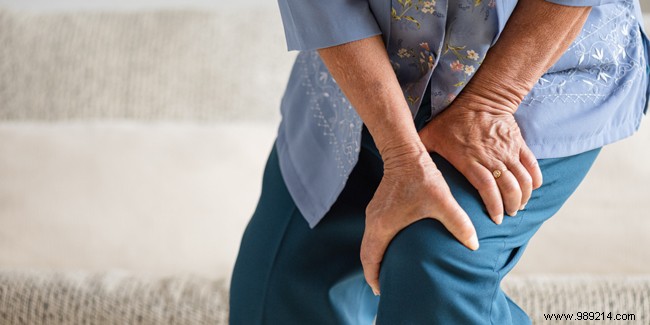
Joint pain increases with age. Also called polyarthralgia, they are unpleasant and sometimes disabling. These pathologies affect the well-being of the people concerned. To treat them, it is important to know the cause. What are the causes of joint pain? How to treat them? Is it possible to prevent them? Here's everything you need to know about it!
Joint pain (sometimes called polyarthralgia) is pain that affects the joints. They can be moderate or intense, occasional or chronic. The causes are multiple and often depend on the state of health and lifestyle of the person concerned. Seniors are particularly affected by joint pain. These affect 1 in 3 people and are mainly caused by osteoarthritis.
If you suffer from persistent or intense joint pain, it is important to make an appointment with your doctor. It is essential to diagnose the health problem causing the pain in order to treat it.
What are the symptoms of joint pain?
Joint pain is easy to recognize. The symptoms are as follows:
Of course, all these symptoms do not appear simultaneously. Depending on the origin of the joint pain, the symptoms vary.
Most joint pain is caused by osteoarthritis. Also called osteoarthritis, this pathology is characterized by abnormal or accelerated wear of the cartilage present in the joints. The knee is often the most affected part of the body. Osteoarthritis is very common in people who are overweight or obese, in top athletes, in seniors (over 70) and in women going through menopause (over 55).
There are different types of osteoarthritis.
There is no treatment for osteoarthritis. However, drug treatments are offered to reduce pain and discomfort. Depending on the profile of the person affected by osteoarthritis, non-drug solutions exist. It is possible to bet on regular physical activity such as walking or swimming, or on weight loss if necessary. Surgery is proposed when the osteoarthritis is too advanced. The patient is then offered the placement of a prosthesis.
Arthritis is an inflammation of the joints. Whether acute or chronic, what used to be called rheumatism generates pain that considerably affects the quality of life of patients. These pains affect joints, ligaments, tendons and bones.
There are different types of arthritis. Among them are:
As with osteoarthritis, there is no cure for arthritis. It is possible to relieve those affected with painkillers or anti-inflammatories. If arthritis is caused by a disease, its progression must be slowed down with appropriate treatment.
Gout is a disease that results in the deposit of uric acid crystals in the joints. It is caused by hyperuricemia, in other words too high a level of uric acid in the blood. The accumulation of crystals leads to gout attacks. Very painful, these inflammatory attacks affect the joints and neighboring areas. Most often, they start with the big toe.
In the event of a gout attack, a medical consultation is essential. It provides painkillers and anti-inflammatories. Doctors can also evacuate fluid that accumulates in the joint. People who suffer from gout must take permanent treatment in order to regulate the level of uric acid in the blood.
Lupus is an autoimmune disease but also a chronic disease. The body makes antibodies that attack healthy cells. This pathology affects the connective tissues and leads to inflammation of the skin, muscles, joints, blood vessels but also of the heart, lungs, kidneys and nervous system. Lupus works in flare-ups. These appear with triggers like:
There is no cure for lupus. However, it is possible to treat flare-ups and improve the daily lives of patients with one-off or long-term treatments. They consist of anti-inflammatories, corticosteroids and immunosuppressants. Immunoglobulin infusions may also be offered.
Scleroderma is, like lupus, a chronic autoimmune disease. It is characterized by hardening of the skin and surrounding tissues. It can therefore concern the joints. The symptoms are the same as in arthritis. In case of systemic scleroderma, the internal organs are also concerned:heart, lungs, kidneys... There are drugs to fight scleroderma. The treatments improve the daily lives of patients.
Joint pain can be prevented. To do this, it is necessary to have an excellent hygiene of life and this, throughout its existence. For example, it is recommended to have regular physical activity, to limit excesses and to maintain a healthy weight. It is important to eat as many fruits and vegetables as possible every day. At the same time, you need to be well hydrated. Remember that cartilage is 75% water!
Joint pain, in its early stages, can be treated with alternative medicine. In particular, you can count on osteopathy and phytotherapy. If the pain persists or intensifies, then you should make an appointment with your doctor.